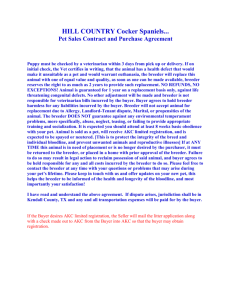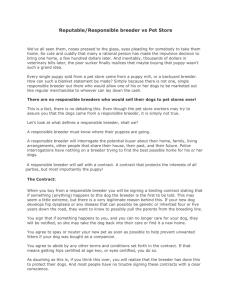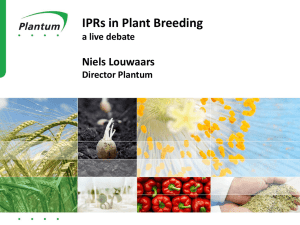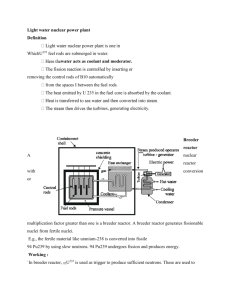The notion of “essentially derived variety”
advertisement
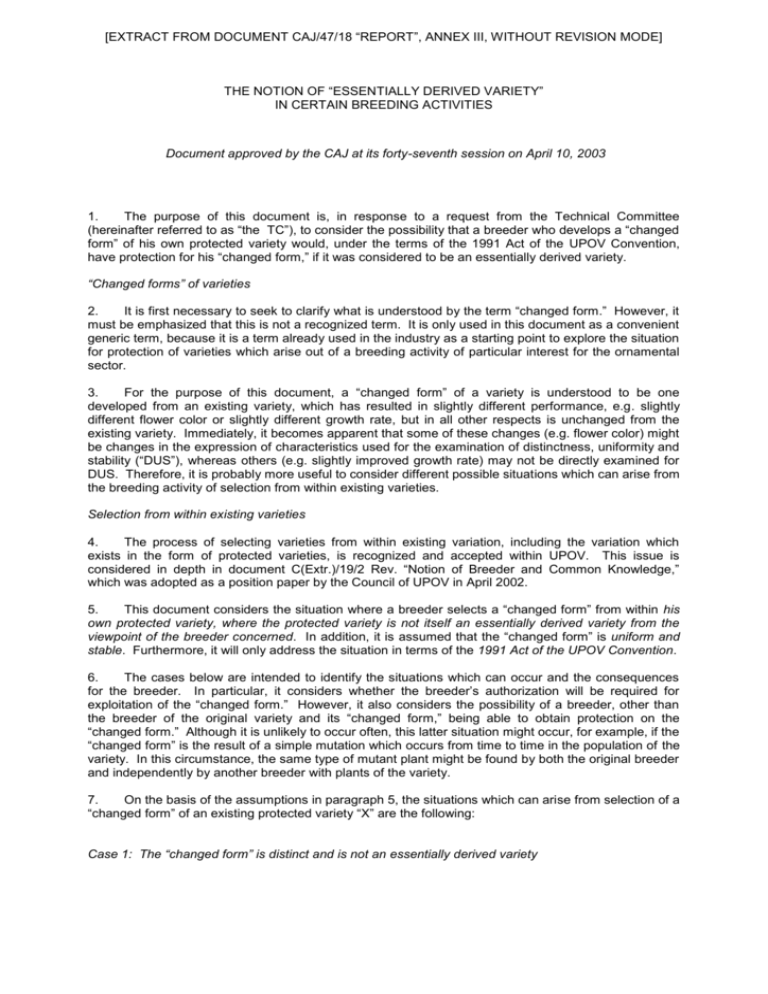
[EXTRACT FROM DOCUMENT CAJ/47/18 “REPORT”, ANNEX III, WITHOUT REVISION MODE] THE NOTION OF “ESSENTIALLY DERIVED VARIETY” IN CERTAIN BREEDING ACTIVITIES Document approved by the CAJ at its forty-seventh session on April 10, 2003 1. The purpose of this document is, in response to a request from the Technical Committee (hereinafter referred to as “the TC”), to consider the possibility that a breeder who develops a “changed form” of his own protected variety would, under the terms of the 1991 Act of the UPOV Convention, have protection for his “changed form,” if it was considered to be an essentially derived variety. “Changed forms” of varieties 2. It is first necessary to seek to clarify what is understood by the term “changed form.” However, it must be emphasized that this is not a recognized term. It is only used in this document as a convenient generic term, because it is a term already used in the industry as a starting point to explore the situation for protection of varieties which arise out of a breeding activity of particular interest for the ornamental sector. 3. For the purpose of this document, a “changed form” of a variety is understood to be one developed from an existing variety, which has resulted in slightly different performance, e.g. slightly different flower color or slightly different growth rate, but in all other respects is unchanged from the existing variety. Immediately, it becomes apparent that some of these changes (e.g. flower color) might be changes in the expression of characteristics used for the examination of distinctness, uniformity and stability (“DUS”), whereas others (e.g. slightly improved growth rate) may not be directly examined for DUS. Therefore, it is probably more useful to consider different possible situations which can arise from the breeding activity of selection from within existing varieties. Selection from within existing varieties 4. The process of selecting varieties from within existing variation, including the variation which exists in the form of protected varieties, is recognized and accepted within UPOV. This issue is considered in depth in document C(Extr.)/19/2 Rev. “Notion of Breeder and Common Knowledge,” which was adopted as a position paper by the Council of UPOV in April 2002. 5. This document considers the situation where a breeder selects a “changed form” from within his own protected variety, where the protected variety is not itself an essentially derived variety from the viewpoint of the breeder concerned. In addition, it is assumed that the “changed form” is uniform and stable. Furthermore, it will only address the situation in terms of the 1991 Act of the UPOV Convention. 6. The cases below are intended to identify the situations which can occur and the consequences for the breeder. In particular, it considers whether the breeder’s authorization will be required for exploitation of the “changed form.” However, it also considers the possibility of a breeder, other than the breeder of the original variety and its “changed form,” being able to obtain protection on the “changed form.” Although it is unlikely to occur often, this latter situation might occur, for example, if the “changed form” is the result of a simple mutation which occurs from time to time in the population of the variety. In this circumstance, the same type of mutant plant might be found by both the original breeder and independently by another breeder with plants of the variety. 7. On the basis of the assumptions in paragraph 5, the situations which can arise from selection of a “changed form” of an existing protected variety “X” are the following: Case 1: The “changed form” is distinct and is not an essentially derived variety page 2 8. The “changed form” will be distinct, but in accordance with Article 14(5) of the 1991 Act of the Convention, will not be an essentially derived variety and, therefore, will not be covered by the scope of protection of variety X if: (a) it is clearly distinguishable from variety X and, either, (b) it is not predominantly derived from variety X, or, (c) it does not conform to variety X in the expression of the essential characteristics that result from the genotype or combination of genotypes of the variety X. 9. In this case, the “changed form” can be commercially exploited without the authorization of the breeder of variety X, unless protection is obtained on the “changed form” itself. If the conditions are fulfilled, the possibility of obtaining protection of the “changed form” is open to any person, and not just the breeder of variety X, who has independently bred the “changed form.” In such a situation, the novelty condition would be of particular relevance. Case 2: The “changed form” is an essentially derived variety 10. The “changed form” will, in accordance with Article 14(5) of the 1991 Act of the Convention, be a variety essentially derived from variety X and covered by the scope of protection of variety X if: (a) it is clearly distinguishable from variety X and (b) it is predominantly derived from variety X, while retaining the essential characteristics that result from the genotype or combination of genotypes of the initial variety and (c) except for the differences which result from the act of derivation, it conforms to variety X in the expression of the essential characteristics that result from the genotype or combination of genotypes of variety X. 11. In this case, commercialization of the “changed form” requires the authorization of the breeder of variety X. It would be possible for another breeder, who had obtained the “changed form” independently, to obtain protection of the “changed form” as a new variety, if all the conditions were fulfilled, but this other breeder would still require the authorization of the breeder of variety X to be able to commercially exploit the variety. 12. The benefit for the breeder of variety X of using the provision for essentially derived varieties is that, for as long as variety X is protected, he has control of the “changed form” without the cost of seeking protection for the new variety. However, there are certain aspects which should be considered by this breeder before deciding not to protect the “changed form” itself. 13. Firstly, it is important to note that the control of the “changed form” only exists for as long as the protection on variety X exists. As soon as the protection on variety X expires, the control over the “changed form” also expires. This is particularly relevant because the breeder may start to maintain only the “changed form” and discontinue maintenance of variety X. In this situation, the authority may decide to cancel the breeder’s right for variety X, on the basis that the breeder could not “… provide the authority with the information, documents or material deemed necessary for verifying the maintenance of the variety,” (Article 22(1)(b)(i) of the 1991 Act of the Convention). 14. Secondly, the risk for the breeder of variety X is that, whilst he may consider the “changed form” to be essentially derived from variety X, this may be challenged by someone wishing to exploit the “changed form” without the authorization of the breeder. It may also be challenged by another breeder page 3 who, having obtained the “changed form” independently, wishes to obtain protection of the “changed form” subject to being able to satisfy the conditions. 15. The balance of risks and benefits in choosing whether to protect the “changed form” will be a matter for the breeder to decide according to his own circumstances. 16. If the breeder decides, on the balance of benefits and risks, that it would be better to protect the “changed form” as a new variety, he can do so, if the conditions for protection are fulfilled. However, it should be noted that if the “changed form” of variety X is protected, say as variety Y, this variety Y will still be an essentially derived variety. Therefore, any “changed form” of variety Y which is considered to be essentially derived from variety Y, will not be covered by the scope of protection of variety Y. This is because, according to Article 14(5)(a)(i) of the 1991 Act of the Convention, the scope of protection of varieties, which are essentially derived from a protected variety, only applies “where the protected variety is not itself an essentially derived variety”. It is possible that a “changed form” of variety Y might also fulfil the conditions required to be considered to be essentially derived from variety X and would then be covered by the scope of protection of variety X. Case 3: The “changed form” is not distinct 17. In accordance with Article 14(5) of the 1991 Act of the Convention, the “changed form” will be covered by the scope of protection of variety X if it is not clearly distinguishable (Article 7 of the 1991 Act of the Convention) from variety X. 18. If the “changed form” is not distinct, it is covered by the scope of protection of variety X and anyone wishing to exploit the “changed form” would require the authorization of the breeder. No other breeder would be able to obtain protection of the “changed form” as a new variety because it would not be distinct. 19. This situation might occur if the breeder applies for protection of the “changed form,” but is refused on the basis that the variety is not distinct. In this case, the situation is clearly as explained in paragraph 18. 20. However, it may be the breeder who considers that the “changed form” is very similar to variety X and does not consider it to be distinct. In this case, which may be the result of an unintended drift in the maintenance of the variety X, there is the risk that the view of the breeder that the “changed form” is not distinct might be challenged. If the authority decides that the “changed form” is distinct and variety X is no longer being maintained it may decide to cancel the breeder’s right for variety X on the basis that the breeder could not “… provide the authority with the information, documents or material deemed necessary for verifying the maintenance of the variety” (Article 22(1)(b)(i) of the 1991 Act of the Convention). The breeder would then have no protection for variety X and may not be able to obtain protection of the “changed form” on the grounds of lack of novelty. In the absence of protection of variety X, regardless of whether the “changed form” is essentially derived from variety X, the “changed form” could be commercially exploited without the authorization of the breeder. 21. It will be a matter for each breeder to ensure that his “changed form” does not become distinct from variety X. Summary 22. The three cases explained above are summarized in the form of a table in the Appendix to this document. [Appendix follows] CAJ/47/8 APPENDIX TO ANNEX III Summary of Situations Which Can Arise from the Selection of a “Changed Form” of Variety X Distinct? Case 1 Case 2 Yes Yes Case 3 No3 “Changed Form” of Variety X Essentially Derived? Can be Protected by Another Breeder? No Yes1 Yes* Yes* Can be Commercially Exploited Without the Authorization of the Breeder of Variety X? Yes No2 No No2 Comment 1. 2. No 3. No guarantee that the “changed form” will be accepted as an essentially derived variety Only for as long as variety X is protected Dependent on whether the competent authority accepts the “changed form” is not distinct [End of Annex III and of document] * Subject to satisfying all other conditions for protection.
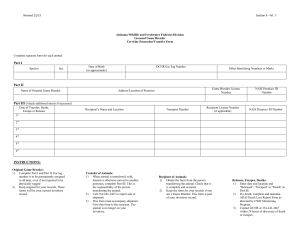
![Animal return form [MS Word Document - 64.3 KB]](http://s3.studylib.net/store/data/006927664_1-6a4a16b4b238da8d31c2a1affc348daa-300x300.png)
